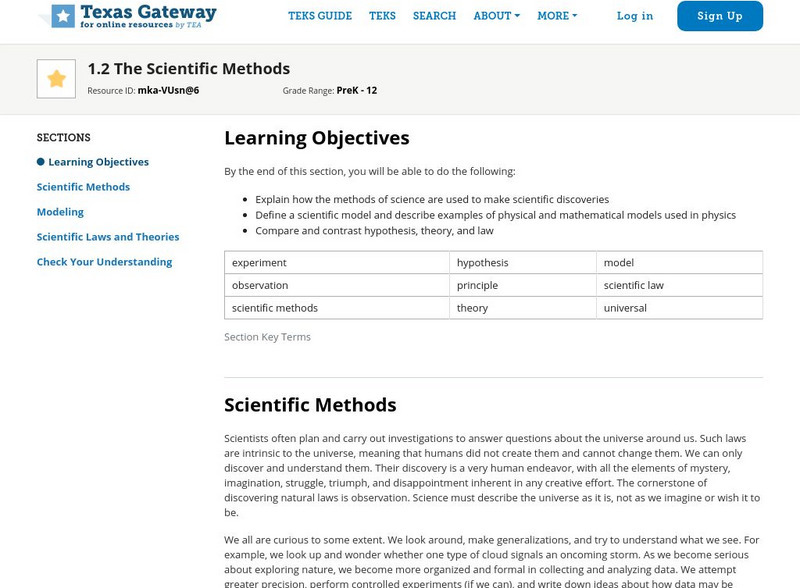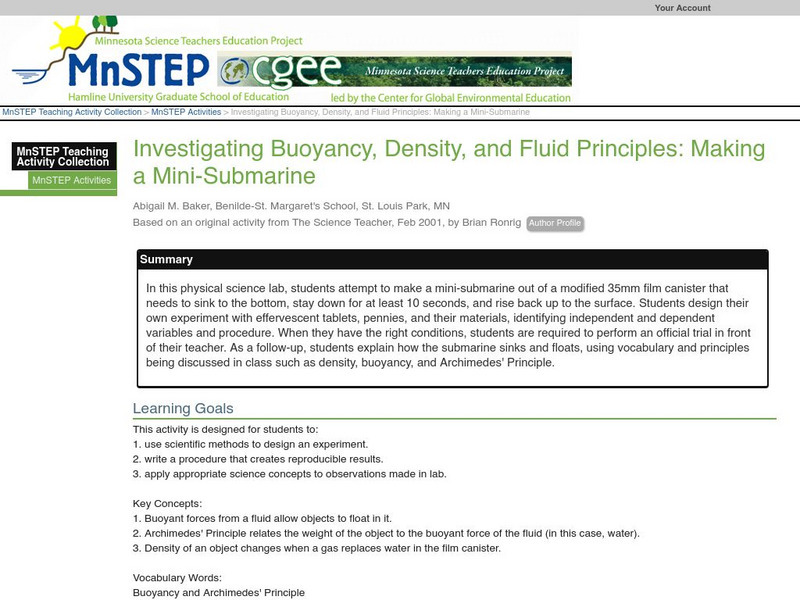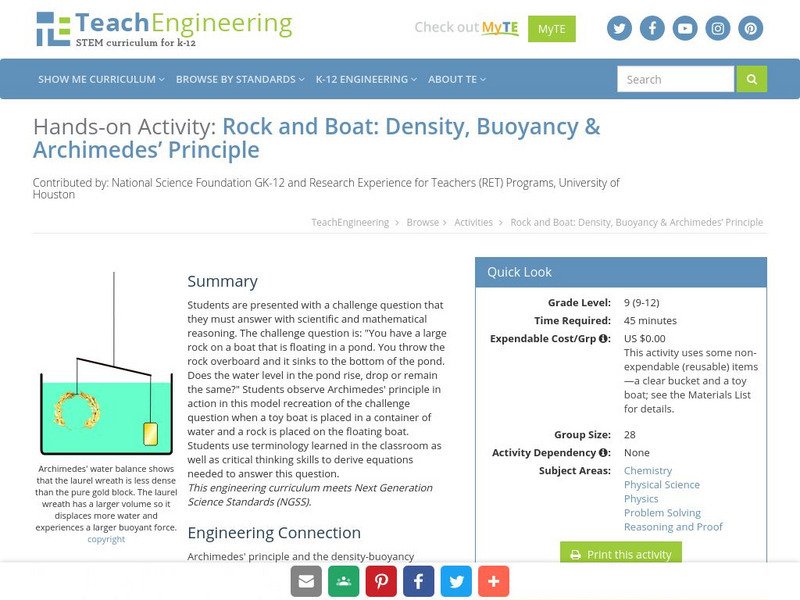Hi, what do you want to do?
Curated OER
Microscopes and Crystals
Learners observe crystals under the microscope. In this science instructional activity, students compare how the crystal look like using their eyes, hand lens and microscope. They identify the type of crystal based on the amount of light...
Curated OER
Physics Rewind
Eighth graders differentiate speed and velocity. For this physics lesson, 8th graders explain Newton's laws of motion. They calculate speed using a mathematical formula.
Curated OER
Charles Darwin's Hardware Shop
Students construct an evolutionary tree representing specialization, diversity, and selection using easily obtained materials. They use at least twenty pieces of hardware to classify then develop "evolutionary" relationships between the...
Texas Education Agency
Texas Gateway: Physics: The Scientific Methods
By the end of this section, you will be able to explain how the methods of science are used to make scientific discoveries; define a scientific model and describe examples of physical and mathematical models used in physics; and compare...
Sophia Learning
Sophia: Principle
This lesson introduces the concept of a scientific principle, and explains their importance in science. [1 min, 49 secs]
National Institute on Drug Abuse
Principles of Drug Addiction Treatment: A Research Based Guide (Third Edition)
The National Institute on Drug Abuse created a guide on the principles of drug addiction treatment. That guide is available here online. It's meant to help individuals answer questions such as finding the most effective methods of...
PBS
Pbs Teachers: Scientific American: Forever Wild? Input and Output
Investigate the scientific principles of biospheres, and observe the effects of biological processes on closed systems.
Science Education Resource Center at Carleton College
Serc: Investigating Buoyancy, Density, and Fluid Principles: Make Mini Submarine
In this lab, students will use the scientific method to design an experiment that explains how/why a submarine floats and sinks.
Internet History Sourcebooks Project
Fordham University: Modern History Sourcebook: The Principles of Scientific Management
An essay by Frederick W. Taylor that outlined his theory of scientific business management, how it worked, and why it was important to industry in the beginning of the 20th century.
Other
Writing Scientific Reports
This tutorial site provides links to articles about writing a scientific report or essay as well as to sample essays.
Sophia Learning
Sophia: Principle: Lesson 4
This lesson introduces the concept of a principle and explains what they represent. It is 4 of 4 in the series titled "Principle."
PBS
Science Odyssey: Heisenberg States Uncertainty Principle
Explains the Heisenberg Uncertainty Principle, that it is impossible to know both the momentum and position of an electron, along with describing the impact that it made upon the scientific community upon its introduction in 1927.
Other
Fagler College/nas 111/scientific Methodology
Power Point presentation on scientific method for NAS 102 Human and Environmental Biology II.
Other
Scientific Management: Frederick Winslow Taylor
Good biography of Frederick Taylor, author of "The Principles of Scientific Management." Includes links to other sites and great pictures.
TeachEngineering
Teach Engineering: Rock and Boat
Students observe Archimedes' principle in action in this challenge where a toy boat is placed in a container of water and a rock is placed on the floating boat. Students must explain why the water level rises/falls/stays the same based...
CK-12 Foundation
Ck 12: Earth Science: Correlation and Causation Study Guide
This comprehensive study guide covers the main terms and concepts needed for an earth science unit on the scientific principles of correlation and causation. Review questions are included at the bottom of the study guide.
Internet History Sourcebooks Project
Fordham University: Modern History Sourcebook: Principles of Natural Philosophy
This site from Fordham University is an exerpt from Newton's famous "Principia."
PBS
Pbs Teachers: Scientific American: Flying High: Bird Man
Investigate and demonstrate principles of flight with the Flying Tim Bird. Draw a hypothetical model of the mechanism inside the toy bird that makes the wings flap, then experiment with and videotape its flight to explain how lift works...
CK-12 Foundation
Ck 12: Earth Science: Scientific Explanations and Interpretations Study Guide
[Free Registration/Login may be required to access all resource tools.] A brief explanation of the difference between facts, observation, and opinions. Includes a few questions to check for understanding.
TeachEngineering
Teach Engineering: Fun With Nanotechnology
Through three teacher-led demonstrations, students are shown samplers of real-world nanotechnology applications involving ferrofluids, quantum dots and gold nanoparticles. This nanomaterials engineering lesson introduces practical...
Utah Education Network
Uen: Amino Acids
Lesson explores scientific principles in using eggs as a highly nutritious and versatile food source of protein.
PBS
Pbs Teachers: Scientific American: Flying Free: Make a Wind Tunnel
Investigate the science of flight, the tilt or angle of attack of a wing's surface and the effect of control surfaces. Construct a model of an open jet wind tunnel using a household desk fan to produce a flow of air.
PBS
Pbs Teachers: Scientific American: Flying Free: Winging It
Explore flight and the science behind lift and wing shape by creating two paper airplanes - a monoplane glider and a ring-wing glider.
PBS
Pbs Teachers: Scientific American: Dragon Science: Food for Thought
Investigate how geneticists use selective breeding to capitalize on hybrid vigor by using colored chips to represent traits in succeeding generations. Use Explain why farmers must buy new hybrid seed each year.


























